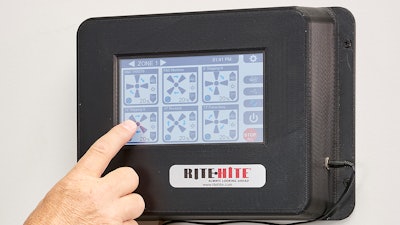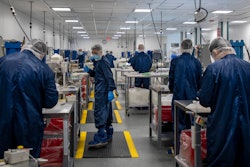
Food manufacturing facilities rely on strict temperature control to mitigate spoilage. Unfortunately, the cost of temperature regulation in these spaces can be exorbitant, which is why facility managers are increasingly looking for ways to create better environmental separation and control of their conditioned air.
Luckily, a host of cost-saving tools and technologies have recently become available to help increase the facility’s HVAC efficiency and lower its energy costs. These measures range from dock equipment upgrades and HVLS fan networks to smart equipment and Industrial Internet of Things (IIoT) platforms.
Starting at the Dock
Traditional methods of shipping and receiving food at loading docks are changing – and for good reason. Typically, the trailer doors and security seal were broken outside on the approach, prior to the trailer’s back-in and engagement with the vehicle restraint. Although this exposure is theoretically brief, it does allow outdoor air to penetrate the trailer. More than a minute or two of exposure is energy inefficient and can create quality concerns.
A comprehensive way to address this issue has been the implementation of “drive through” loading docks. In this design, a tractor-trailer backs up to the dock with its doors closed. When the trailer is secured to the dock properly with a vehicle restraint, the dock door opens, the trailer’s security seal is broken, and the trailer doors are opened into the building. This limits opportunities for tampering and exposure to outside elements and contaminants that could degrade the cargo or break cold chain integrity.
The essential component in a drive through loading dock is a vertical-storing leveler, since – unlike traditional horizontal pit-style levelers – vertical levelers allow the trailer doors to swing open inside the building. Advanced vertical levelers will have the same smooth transition as pit-style levelers, but also have maintenance advantages since they store up and out of the way, facilitating easy cleaning in the pit below.
IoT and Air Quality Consistency
Moving inside the facility, the benefits of high-volume low-speed (HVLS) fans go beyond just keeping a cooler temperature in the work zone. They can “destratify” the air, helping to stabilize temperatures from floor to ceiling and allow the thermostat set point to be more accurate. They do this by moving layers of heated air as they gently circulate warm air from the ceiling back toward employees at the floor level.
In destratifying the air, the building’s HVAC systems will work better, last longer, and use less energy.
HVLS fans can be further optimized through smart technology that can control as many as 24 fans at once from a single touchscreen. Fan networking can greatly increase fan efficiency and overall HVAC performance by setting fan speeds to meet the needs of specific areas of a facility that might experience temperature variations due to interior factors like production equipment, or external factors like ambient sunlight or open loading dock doors.
Smart-enabled equipment (like high-speed doors using sensors) can provide valuable data on energy use. When connecting these products with an IIoT platform, it’s possible to see what parts of the facility are using energy. This information allows facility managers to make data-driven decisions to improve energy usage and help reduce costs.
Lower Energy Bills
Facility managers can view energy trends with customized comparisons by day, week, month, or annually on a single door or group of doors. This energy use breakdown can help identify inefficiencies, such as excessive opens, average cycle time, and false activations (when a door opens and nothing was detected going through). All these events can have a negative impact on energy usage, if not properly monitored.
The most advanced IIoT solutions allow facility managers to go beyond simple measurements of cycles by providing customized comparisons, analysis tools, as well as trend alerts and updates in real-time. Through customized comparisons, facility managers can identify root causes of energy usage and ways to help increase the lifetime value of equipment. Facility managers can take immediate action, if necessary, when utilizing IIoT software that provide trends and alerts.
Reducing energy consumption in large facilities can seem like a daunting task with so many factors contributing to energy waste. But new (and widely available) solutions can make a world of difference from loading docks to inside the plant. These tools and technologies not only help lower energy costs, but also enhance efficiency, product integrity and employee morale.






















